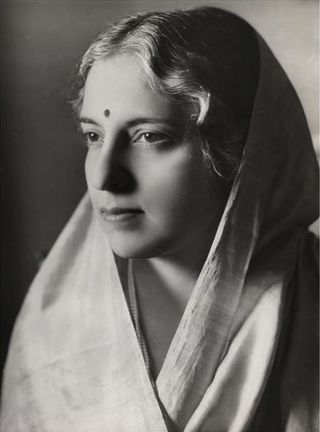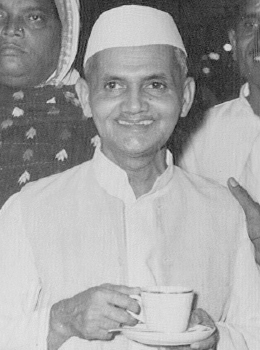
The prime minister of India is the head of government of the Republic of India. Executive authority is vested in the prime minister and his chosen Council of Ministers, despite the president of India being the nominal head of the executive. The prime minister has to be a member of one of the houses of bicameral Parliament of India, alongside heading the respective house. The prime minister and his cabinet are at all times responsible to the Lok Sabha.

The Indian National Congress (INC), colloquially the Congress Party or simply the Congress, is a political party in India with deep roots in most regions of India. Founded on 28 December 1885, it was the first modern nationalist movement to emerge in the British Empire in Asia and Africa. From the late 19th century, and especially after 1920, under the leadership of Mahatma Gandhi, the Congress became the principal leader of the Indian independence movement. The Congress led India to independence from the United Kingdom, and significantly influenced other anti-colonial nationalist movements in the British Empire.

The Parliament of India is the supreme legislative body of the Republic of India. It is a bicameral legislature composed of the Rajya Sabha and the Lok Sabha. The President of India, in their role as head of the legislature, has full powers to summon and prorogue either house of Parliament or to dissolve the Lok Sabha, but they can exercise these powers only upon the advice of the Prime Minister and their Union Council of Ministers.

Vijaya Lakshmi Pandit was an Indian freedom fighter, diplomat and politician. She served as the 8th President of the United Nations General Assembly from 1953 to 1954, the first woman appointed to this post. She was also the 3rd Governor of Maharashtra from 1962 to 1964. Noted for her participation in the Indian independence movement, she was jailed several times during the movement.

Ahmedbhai Muhamedbhai Patel, also known as Ahmed Patel, was an Indian politician and Member of Parliament from the Indian National Congress. He was the political secretary to Congress President Sonia Gandhi.

The Chief of the Naval Staff (CNS) is a statutory office held by the professional head of the Indian Navy (IN), the naval branch of the Indian Armed Forces. Customarily held by a four-star admiral, the CNS is the senior-most operational officer of the IN, tasked with the roles of overseeing the force's overall functioning during states of peace and conflict, along with the realization of India's strategic maritime objectives, namely, the defence of the country's sovereignty against maritime threats and the security of international sea lines in the Indo-Pacific.

Kotha Raghuramaiah (1912–1979) was a veteran Indian politician and barrister who served as the Union Cabinet minister of Defence, Civil Aviation, Petroleum & Chemicals, Tourism and Parliamentary Affairs. He is one of the longest-serving cabinet minister in the History of India. The Members of Parliament from the Lok sabha and Rajya Sabha participate in a friendly Cricket competition annually for the honor of lifting the Raghuramaiah Trophy named after him.

Sharad Yadav was an Indian politician from the Rashtriya Janata Dal (RJD) party. He was elected to the Lok Sabha seven times and to the Rajya Sabha four times from JD(U). He was the first national president of Janata Dal (United), serving from its formation in 2003 until 2016. He was disqualified from the Rajya Sabha in 2017 and removed from party leadership positions for engaging in anti-party activities.
Brijlal Verma was a cabinet minister in Morarji Desai ministry in India. He held communication portfolio from 1977 to 1979. He was elected to Lok Sabha from Mahasamund on a Janata Party ticket.

Ozhalur Viswanatha Mudaliar Alagesan was an Indian politician and freedom fighter from the Indian state of Tamil Nadu. He served as a Member of parliament, Lok Sabha from 1952 to 1957, 1962 to 1967 and from 1971 to 1980.

Nityanand Kanungo was one of India's prominent politicians from the state of Odisha, who held successive high-profile portfolios in Prime Minister Jawaharlal Nehru's cabinet.

Jitendra Singh is an Indian physician and politician who serving as 18th Minister of Science and Technology and Minister of Earth Sciences since 2024. For Prime Minister's Office; Personnel, Public Grievances and Pensions; Department of Atomic Energy and Department of Space. He was elected to 18th Lok Sabha from Udhampur with the majority of 1,24,373 votes.

Lal Bahadur Shastri was sworn in as Prime Minister of India on 9 June 1964. In his ministry, the ministers were as follows.

Charan Singh was sworn in as Prime Minister on 28 July 1979, with outside support by Indira Congress and Yashwantrao Chavan of Congress (Socialist) faction as his Deputy PM. Just before Singh was to prove his majority in Lok Sabha, Indira Gandhi withdrew support to his government, and he resigned on 20 August 1979, after just 23 days, becoming the only PM who didn't face the parliament. He advised President Neelam Sanjiva Reddy to dissolve Lok Sabha. Janata Party leader Jagjivan Ram challenged the advice and sought time to cobble support. But Lok Sabha was dissolved, and Charan Singh continued as caretaker PM until January 1980.
Anant Prasad Sharma was an Indian Railway Union leader, politician who became Minister of State for Industry, and Union Minister of the government of India. He was also the Governor of the State of Punjab and the State of West Bengal. He was a member of the 3rd Lok Sabha and 5th Lok Sabha from Buxar. He was a member of the Rajya Sabha three times, in 1968–1971, 1978–1983 and 1984–1988.

The Third Jawaharlal Nehru ministry was formed on 17 April 1957 after the Indian National Congress won the 1957 general election with a vast majority.

The Fourth Jawaharlal Nehru ministry was formed on 2 April 1962 after the Indian National Congress won the 1962 general election.
Govind Kanhai is an Indian artist and painter. He completed his post graduation in philosophy from Dr. Bhimrao Ambedkar University formerly known as Agra University.
Satish Chandra was an Indian politician. He was elected to the Lok Sabha, the lower house of the Parliament of India from the Bareilly, Uttar Pradesh as a member of the Indian National Congress. He was the Deputy Minister for Defence, 1952–1955, Deputy Minister for Production, 1955–1957 and Deputy Minister for Commerce and Industry, 1957–1962 in the Nehru Ministry.














